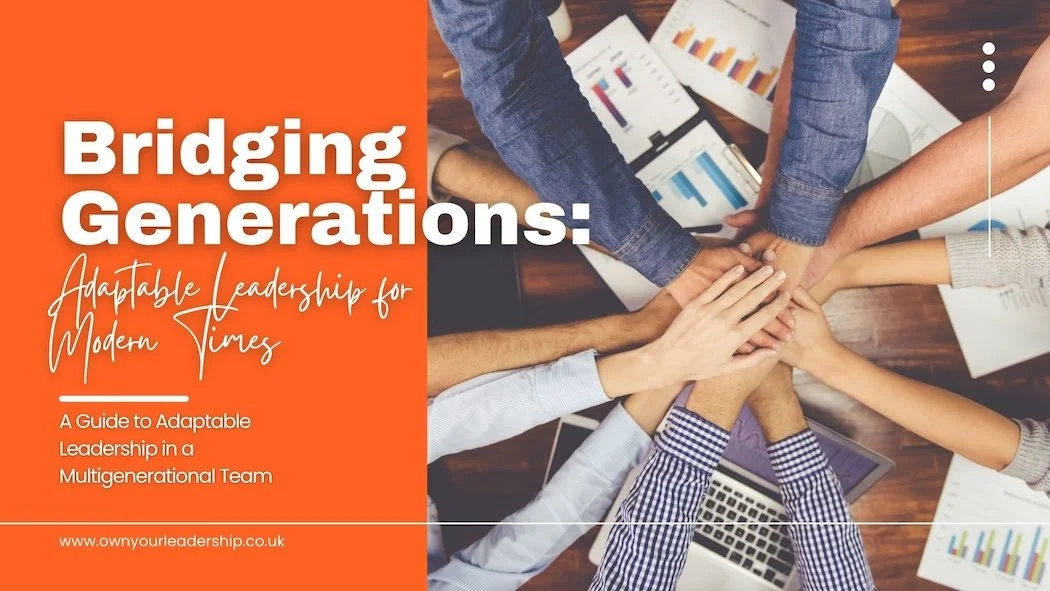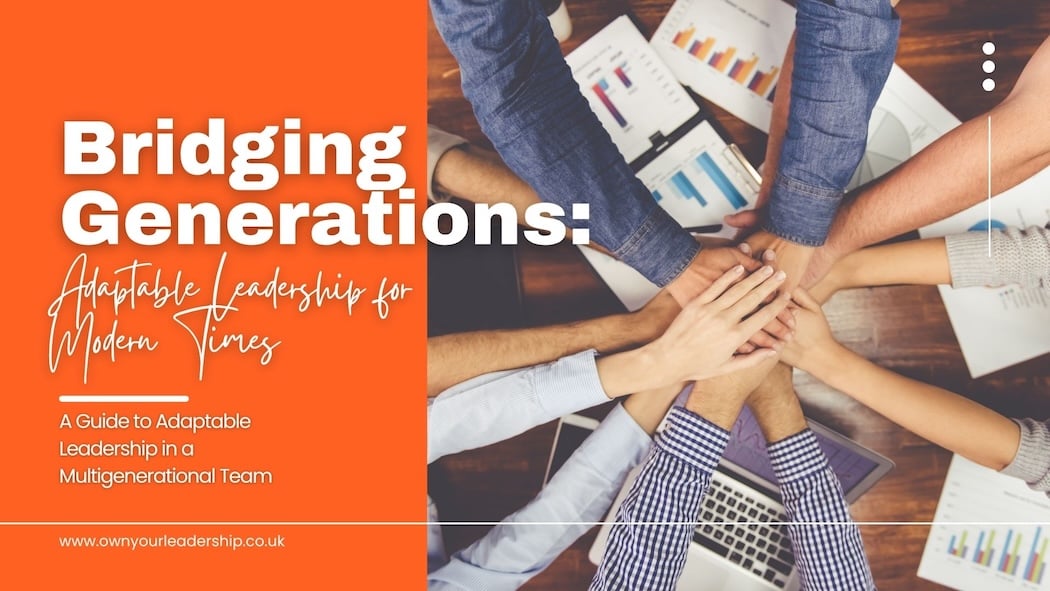Adaptable Leadership in Multigenerational Teams
How to harness strength and build connection
Adopting an adaptable leadership approach is essential for the success of teams made up of members from diverse generations, backgrounds, and life experiences, but leading multigenerational teams is one of the most rewarding — and sometimes challenging — aspects of modern leadership.
Each generation brings unique perspectives, strengths, tolerance levels and ways of working, which can create both opportunities and tension within a team.
As a leader, understanding these differences and adapting your leadership approach is essential to unlock your team’s full potential. From communication preferences to work motivations, each layer of generational diversity influences how your team collaborates and performs.
In this blog, I explore practical strategies for leading multigenerational teams, helping you foster engagement, creativity, and effective teamwork across all age groups.
Why Generational Understanding Matters
I was recently reminded of the importance of generational awareness while watching Netflix’s Adolescence. The show highlighted the gulf between teenagers and their parents and how each generation struggles to understand the other’s world.
It struck me how similar dynamics appear in the workplace.
Leaders and teams often operate within the lens of their own experience, which can unintentionally create bias or blind spots.
I’ve seen this in my own career.
My first boss had led the same school for 25 years. His approach was shaped by decades of routine and tradition, which limited exposure to new ideas. In contrast, my own early career included four years of teacher induction, placements across multiple schools, and exposure to varied leadership styles.
I had a broader perspective, which allowed me to see possibilities he simply hadn’t considered. It showed in how he treated me, and how my thoughts and opinions were not valued.
The lesson is clear: we only know what we know, and our experience shapes how we lead.
Understanding Generational Traits
Before you can lead multigenerational teams effectively, it helps to understand broad tendencies across generations.
These tendencies help leaders anticipate differences and adapt without stereotyping or undervaluing individuals.
Applying Adaptable Leadership in Multigenerational Teams
Leading a team made up of different generations isn’t about rigid rules or following a strict way of working; it does not involve a ‘my way or the highway’ approach. Adaptable leadership in multigenerational teams is about understanding each person’s motivations, strengths, and preferred ways of working, and creating an environment where everyone can contribute their best.
It’s about curiosity, empathy, and flexibility — and knowing that your perspective (as a leader of a team) is just one perspective among many.
Here’s how you can approach this in a way that feels natural, human, and effective:
Reflect on your own assumptions and biases. Before trying to understand others, take a moment to notice where your own beliefs about age, experience, or work style might influence how you interact with your team. Journaling or discussing with a trusted mentor can help make these assumptions visible.
Understand what drives each individual. Spend time connecting with team members one-on-one. Ask open questions like, “What motivates you most in this work?” or “How do you prefer to communicate and receive feedback?” These conversations reveal values and priorities, not just generational differences.
Co-create ways of working. Bring the team together to discuss workflows, communication preferences, and collaboration approaches. For example, balance speed and innovation with experience and quality by designing hybrid processes or shared checkpoints that respect different working styles.
Blend communication approaches. Some team members may prefer structured, in-person updates, while others thrive on digital, rapid feedback. Adaptable leadership in multigenerational teams involves finding a mix that ensures everyone is informed, engaged, and heard.
Leverage reverse mentoring and peer learning. Encourage knowledge sharing across generations. Younger colleagues can mentor on new technologies or trends, while more experienced team members provide guidance on strategic thinking and organisational knowledge. This builds trust, flattens hierarchies, and strengthens collaboration.
Foster psychological safety. Make it clear that all perspectives are valued. Celebrate contributions from each generation and model openness by admitting gaps in your own knowledge. When team members feel safe to experiment, speak up, and challenge ideas, engagement and innovation naturally rise.
By approaching leadership this way, you create an environment where adaptable leadership in multigenerational teams becomes part of the team’s culture. The goal isn’t to eliminate differences but to harness them, turning diversity of experience and perspective into a source of creativity, trust, and performance.
So, what does that look like in action?
Reflect on your own biases
First and foremost, adaptable leadership begins with self-awareness. Without reflection, unconscious assumptions about age, experience, or work style can shape decisions.
Emma, my client, noticed she was siding with her senior colleagues by default. Recognising her bias allowed her to create space for all perspectives. I encouraged her to take note of moments during the week when age or experience influenced her assumptions or decisions. Bringing her unconscious bias to the forefront enabled Emma to explore her reasons for this, but more importantly, how she could mitigate this to help her adapt her leadership to support working fairly and openly with her multigenerational team.
Understand motivations and strengths
Emma took the time to meet individually with each team member. Sophie, a younger colleague, wanted speed and innovation, while Mark, a senior team member, valued reliability and long-term quality. These differences weren’t about age per se, they were about values, motivations, and experiences.
She asked each of them:
What outcomes are most important to you?
How do you prefer to communicate and receive feedback?
What support helps you perform at your best?
Understanding our team members’ motivations allows leaders to align tasks with strengths and reduce conflict.
Co-create solutions
With insights from her team, Emma facilitated a collaborative discussion to co-create a plan balancing innovation and safeguards, which looked like this:
Controlled experimentation: Sophie trialled her workflow on a small scale.
Checkpoints and feedback loops: Mark reviewed results at predefined stages.
Shared accountability: Both agreed on responsibilities and outcomes.
Emma realised it was important to frame challenges around shared goals, not individual preferences. Co-creation was key to encouraging ownership and trust.
Adaptable communication and feedback
Generational differences often emerge most in communication with older members of the team usually preferring structured, in-person updates, and younger members preferring concise, digital, real-time feedback. (And again, I generalise, so if this is not your default, please do not be offended).
Emma implemented hybrid communication with her team: short digital check-ins daily and weekly in-person alignment meetings. This respected everyone’s preferences while keeping collaboration effective.
It’s crucial to map your team’s communication preferences and experiment with blended approaches in order to keep your team’s needs met, allow your team to see you as the leader has been adaptable to their each individual’s needs. It’s as equally crucial to monitor how these work for all, and constantly consider other options available to the team to make everything smooth and accessible for all. It’s now more than ever, crucially important to stay abreast of new AI methods of working that can assist teams in working more smartly and save crucial time where appropriate and preferable.
Leverage reverse mentoring
Reverse mentoring, where younger team members mentor senior colleagues, is a powerful tool.
It encourages knowledge sharing, flattens hierarchies, and builds respect across generations. It’s not to be scoffed at!
When leaders create opportunities for younger and older members of the team to exchange skills, perspectives, or insights, then relationships strengthen, respect grows, trust and support increase, and divisions and biases decrease. And whilst you are at it, why not celebrate collaboration as a team achievement!!
Foster psychological safety
Psychological safety is essential for multigenerational teams.
Emma modelled openness by admitting what she didn’t know, inviting honest input, and acknowledging contributions from every age group.
It’s so important to remember that teams thrive when all voices feel valued and safe. And if you don’t know if that is how your team feels, then regularly ask:
Can everyone share ideas without fear of judgment?
Are diverse perspectives actively valued and acted upon?
….and be prepared to take the feedback firmly on the chin, and then take action to ensure people can share openly, and that you and the rest of the team ensure they are listened to and heard.
Key takeaways so you can adapt your leadership style for multigenerational teams
Generational differences are opportunities for growth, innovation, and engagement.
Reflect on your own biases and assumptions.
Understand motivations and strengths to align tasks effectively.
Co-create solutions collaboratively with your team.
Adapt communication and feedback to suit diverse preferences.
Leverage reverse mentoring to empower everyone.
Foster psychological safety so all voices are heard and respected.
When leaders approach multigenerational teams with curiosity, empathy, and strategic thinking, tension transforms into collaboration, creativity, and stronger outcomes.
Start small: reflect on your assumptions, have one conversation with a team member from a different generation, and test one co-created solution. Over time, these small actions build a thriving, inclusive, and high-performing team.
If you’d like help to tackle any multi-generational challenges in your team, then please do reach out for a discovery call to see how I can support you in your own leadership role or help your organisation improve how it works with multi-generational teams.
Or…. download my free e-book below for more support, and access to the leader checklist within.




